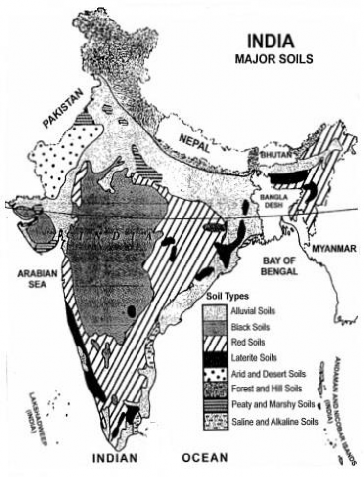5.4.1. Soil Classification in India
In ancient times, soils used to be classified into two main groups – Urvara and Usara, which were fertile and sterile, respectively. The National Bureau of Soil Survey and the Land Use Planning an Institute under the control of the Indian Council of Agricultural Research (ICAR) did a lot of studies on Indian soils. ICAR has classified Indian soils into eight types on the basis of their formation, colour, composition and location. These are described shortly below.
♤ Alluvial Soil – it is formed by rivers by depositing sediments brought from the mountains. The new alluvium is called Khadar while older deposited one is called Bangar. Khadar is renewed annually with fresh floods. Alluvial soils are most widespread in the northern plains and the covers about 40 per cent of the total area of the country. Through a narrow corridor in Rajasthan, they extend into the plains of Gujarat. In the Peninsular region, they are found in deltas of the east coast and in the river valleys. These soils are more loamy and clayey in the lower and middle Ganga plain and the Brahamaputra valley. The sand content decreases from the west to east. They are generally rich in potash but poor in phosphorous. Alluvial soils are intensively cultivated.
♤ Black Soil – it is formed from the volcanic lava. On account of high iron content and humus it is of black colour. It is also known as the Regur soil or black cotton soil. It covers most of the Deccan Plateau. In the upper reaches of the Godavari and the Krishna, and the north western part of the Deccan Plateau, the black soil is very deep. Black soil is spread over 5.18 lakh sqkm area of the country. These soils are known for their ‘self ploughing’ nature. The black soils are generally clayey, deep and impermeable. They swell and become sticky when wet and shrink when dried. So, during the dry season, these soils develop wide cracks. the black soil retains the moisture for a very long time, which helps the crops, especially, the rain fed ones, to sustain even during the dry season.
♤ Red and Yellow Soil – it is formed from weathering of crystalline granite (igneous rocks) and gneiss (metamorphic rocks) in areas of low rainfall in the eastern and southern part of the
Deccan plateau. Along the piedmont zone of the Western Ghat, long stretch of area is occupied by red loamy soil. The soil develops a reddish colour due to a wide diffusion of iron in crystalline and metamorphic rocks. It looks yellow when it occurs in a hydrated form. They are generally rich in minerals like Iron, lime and potash but poor in nitrogen, phosphorous and humus.
♤ Laterite Soil – it is formed under specific monsoon conditions of climate. The dry season after rainfall is one of the speciality of monsoon climate. Under such conditions, leaching of soils is accelerated. This process reduces the silica content of rocks in soils leaving the soil rich in iron and aluminum content. Humus content of the soil is removed fast by bacteria that thrive well in high temperature. These soils are poor in organic matter, nitrogen, phosphate and calcium, while iron oxide and potash are in excess. Hence, laterites are not suitable for cultivation; however, application of manures and fertilizers are required for making the soils fertile for cultivation. Red laterite soils in Tamil Nadu, Andhra Pradesh and Kerala are more suitable for tree crops like cashewnut. Laterite soils are widely cut as bricks for use in house construction.
♤ Arid Soil – in the deserts, accelerated weathering of rocks take place on account of heating during day and cooling during night. In this type of soil mainly sand grains are found with little or no humus. In some areas, the salt content is so high that common salt is obtained by evaporating the saline water. It has also less capacity to hold moisture. Its colour varies from red to brown. Nitrogen is insufficient and the phosphate content is normal. Arid soils are characteristically developed in western Rajasthan and semi-arid type in southern Punjab and Haryana.

